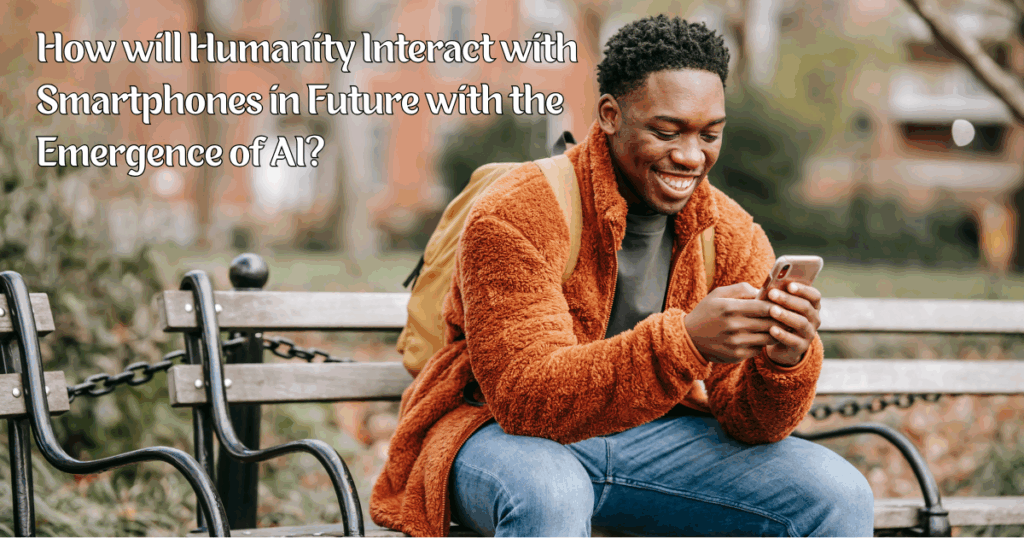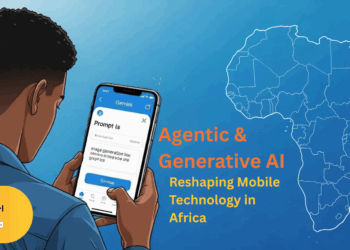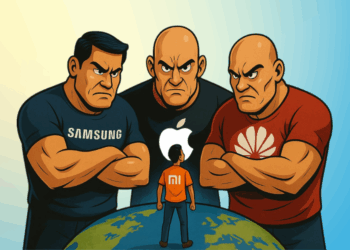The Transformative AI Era: The Beginning
Artificial Intelligence is transforming smartphones—and we are the lucky generation witnessing this digital awakening. For those born in the 1980s, the journey from analog simplicity to AI-powered complexity is a story worth telling. As we shuttle through time aboard Mother Earth—herself orbiting the vast Adrena Supergalaxy—AI is making its virtual revolutions, reshaping how we live, connect, and create.
In 2025, AI has become the definitive force behind smartphone innovation. From camera systems that rival professional gear to battery optimizers that learn your daily rhythm, AI is now embedded in nearly every layer of the mobile experience. It’s not just a feature—it’s the foundation.
In Kenya and across Africa, smartphones are more than tools—they’re lifelines for creativity, commerce, and connection. AI is helping users shoot better content, save battery in low-power zones, and interact in local languages. It’s empowering creators, streamlining communication, and making technology more inclusive and intuitive.
This article explores how AI is transforming smartphones across five key pillars: photography, battery life, personalization, privacy, and regional relevance. And we will do it using real, locally available devices—the ones you will find in stores today. Welcome to the new era of mobile intelligence. Read about the best chipsets on smartphones in 2025 that are shaping how we use the devices.
AI Continued Application across Functions
AI in Smartphone Cameras
Smartphone photography in 2025 has evolved from simple point-and-shoot to intelligent, adaptive image creation. Thanks to artificial intelligence, cameras are no longer just hardware—they are smart systems that analyze scenes, enhance details, and even edit photos in real time. Whether you are a professional content creator or a casual user capturing weekend memories, AI makes photography more accessible, powerful, and expressive.
Key Features That Matter
Scene Optimization
AI instantly detects what you are photographing—be it a sunset, a plate of food, or a group selfie—and adjusts exposure, saturation, and contrast accordingly. Phones like the Galaxy S25 Ultra and Pixel 9 Pro XL use multi-layer scene detection to fine-tune every shot.
Portrait Mode
Using depth AI, smartphones simulate DSLR-style bokeh with stunning accuracy. The Xiaomi 15 Ultra and Vivo X100 Pro+ offer customizable blur levels and edge detection that rival professional lenses.
Night Mode
Multi-frame processing and AI noise reduction allow phones to capture bright, detailed images even in near darkness. Xiaomi 15 Ultra uses HyperAI, its proprietary imaging engine within HyperOS, to maximize low-light image quality. It intelligently enhances dynamic range, reduces noise, and fine-tunes exposure using AI scene recognition and multi-frame fusion. Paired with Leica’s Summilux optics and a large 1-inch sensor, it captures more light and detail. The AI also optimizes periscope telephoto shots, ensuring clarity even when zoomed. Whether shooting cityscapes or portraits at night, HyperAI delivers stunning, true-to-life results with minimal effort.
AI Eraser & Object Removal
With a tap, you can remove unwanted elements from photos. Google’s Magic Editor on the Pixel 9 Pro XL and AI Erase 2.0 on the Vivo Y400 5G make this feature intuitive and fast.
Why It Matters for Everyone
For professionals, AI reduces the need for manual settings and post-processing. For amateurs, it means fewer blurry shots and more confidence behind the lens. You don’t need to understand aperture or ISO—your phone thinks for you.
Even mid-range phones like the Reno14 F 5G and Tecno Phantom V Flip 2 now offer AI-powered beautification tuned for African skin tones, making representation and inclusivity part of the tech experience.
Comparison Chart: AI Camera Features in 2025
| Feature | Galaxy S25 Ultra | Pixel 9 Pro XL | Xiaomi 15 Ultra | Vivo X100 Pro+ |
| Scene Recognition | Advanced | Advanced | Smart Scene AI | Zeiss Optics AI |
| AI Eraser | Generative Edit | Magic Editor | AI Expand | Object Removal |
| Beautification (African Skin) | Adaptive | Inclusive | Tone Mapping | Portrait Master |
| Night Mode | Astro Mode | Low-light Boost | Night Vision AI | Multi-frame Boost |
“AI cameras now understand melanin-rich skin tones better than ever. It’s not just about beauty—it’s about representation.” — Isa Marcial, Tech Reviewer.
In short, AI has democratized photography. Whether you’re shooting for social media, storytelling, or just fun, your smartphone is now your smartest creative partner.
Battery & Performance Optimization
Battery anxiety is finally fading—and AI is the reason why. In 2025, smartphones don’t just store power; they manage it intelligently. As mobile usage grows—from streaming and gaming to content creation and mobile payments—AI ensures your battery keeps up without burning out.
Emerging Innovations
- Adaptive Charging: Your phone now learns your routine. It charges quickly to 80%, then slows down overnight to preserve battery health. Devices like the OnePlus 13 Ultra and Xiaomi Mi 14 Ultra use AI to prevent overcharging and extend battery lifespan by up to 40%.
- Thermal Management: AI monitors heat during gaming or multitasking and adjusts processor load to keep your phone cool. The Vivo X Fold 5 and Galaxy Z Fold 7 use this to prevent overheating and performance drops.
- App Prediction: Phones like the Pixel 9 Pro XL preload your most-used apps before you open them, reducing lag and saving energy.
- Idle App Control: AI pauses background apps you are not using, freeing up power for what matters most.
For Kenyan users juggling mobile data, multitasking, and long days without charging, these features are game-changers. Even mid-range phones like the Redmi Note 15 Pro+, Oppo Reno14 F 5G, and Tecno Spark 20 Pro+ now include smart battery modes that adapt to your lifestyle.
Looking back, this is a milestone. Looking ahead, it’s a promise: smarter power, longer life, and fewer compromises.
Real-World Impact
| Device | Battery Capacity | Charging Speed | AI Battery Feature |
| OnePlus 13 | 6,000mAh | 100W SuperVOOC | AI Smart Charging |
| Xiaomi 15 Ultra | 5,410mAh | 90W HyperCharge | AI Power Delivery |
| Galaxy Z Fold7 | 4,400mAh | 25W | AI Smart Battery Plus |
| Vivo X Fold 5 | 6,000mAh | 80W | AI Thermal Management |
“AI battery systems are the unsung heroes of 2025. They make phones smarter, cooler, and longer-lasting.” — Faizan R., Battery Tech Analyst
Personalization & UX
AI is revolutionizing personalization and User eXperience (UX), turning smartphones into intuitive companions that adapt to individual needs, habits, and emotions. Today’s flagship devices go beyond static interfaces, offering dynamic, hyper-personalized experiences powered by advanced on-device intelligence.
Smart UI Layouts now rearrange apps, widgets, and shortcuts based on time, location, and behavioral patterns. For instance, your fitness app surfaces in the morning, while ride-hailing and payment tools dominate during your commute. This context-aware design minimizes friction and enhances usability.
Voice Assistants have evolved to understand regional dialects, slang, and even cultural nuances. Whether you’re speaking Sheng in Nairobi, Swahili in Mombasa, or Yoruba in Lagos, AI models now interpret intent with remarkable accuracy, making digital interactions more natural and inclusive.
Emotion-Aware UX is another frontier. Using facial cues, typing patterns, and voice tone, devices adjust interface colors, notification styles, and even assistant responses to match your mood—offering empathy-driven design that feels human.
Offline AI ensures that personalization doesn’t rely on constant connectivity. Features like predictive text, smart replies, and app suggestions now work seamlessly in low-data environments, empowering users in underserved regions.
Device Examples:
- Pixel 9 Pro XL: Gemini Nano enables on-device summarization, smart replies, and contextual app actions.
- Samsung Galaxy S25 Ultra: Now Brief offers real-time summaries of weather, traffic, and calendar events.
- OnePlus 13: PlusMind intelligently stores and recalls fragmented information across apps, streamlining multitasking.
Together, these innovations mark a shift toward deeply personal, emotionally intelligent, and regionally relevant mobile experiences.
“In Kenya, phones that adapt to your rhythm—whether you’re in Nairobi traffic or offline in Turkana—are game-changers.” — ProtoAI Team
Security & Privacy
AI is redefining mobile security and privacy by blending robust protection with seamless convenience. Today’s smartphones are equipped with intelligent systems that not only safeguard user data but also anticipate threats in real time. A Samsung brand loyalist, I find their security features mind-settling in a world where data breaches and privacy issues are on the rise. With AI, I believe we will have more intelligent interventions in terms of data security and privacy.
How is AI making phones more secure—without compromising convenience?

The Quest for Better Security and Privacy using AI
Face Unlock with Depth AI uses advanced 3D mapping and infrared sensing to create a highly accurate facial profile. Unlike traditional 2D recognition, it resists spoofing attempts using photos or masks, ensuring only the rightful user gains access—even in low light or with accessories like glasses.
On-Device Processing ensures sensitive data—like biometric authentication, passwords, and personal preferences—never leaves the device. AI models run locally, reducing exposure to cloud-based vulnerabilities and enhancing user trust, especially in privacy-conscious regions.
Fraud Detection is now proactive. AI continuously monitors for suspicious activity such as SIM swaps, unauthorized access attempts, and phishing links. It alerts users instantly and can even restrict access to compromised apps or networks.
Privacy Zones use AI to detect and blur sensitive information—like contact details, bank balances, or faces—in screenshots and shared images. This protects users from accidental data leaks during social sharing or remote support.
Together, these AI-driven features create a security ecosystem that’s smarter, faster, and more intuitive—empowering users to stay protected without sacrificing ease of use.
Secure Devices in 2025
| Device | AI Security Feature |
| iPhone 16 Pro Max | Neural Engine 4.0 + Private Cloud Compute |
| Galaxy S25 Ultra | Knox Matrix + AI malware scanning |
| Huawei Mate 60 Pro | Behavioral AI + Facial Analytics |
| Pixel 9 Pro XL | AI Call Screening + Voice Recognition |
“AI security isn’t just about locking your phone—it’s about protecting your life.” — Simran Mishra, Cybersecurity Analyst.
Regional Relevance: AI for Africa
AI is no longer a distant promise—it’s here, speaking our languages and solving real-world challenges across Africa. From Swahili voice assistants to melanin-aware beautification, today’s smartphones are built to serve, not just impress.
Localized Features
Localized Intelligence
Voice assistants now speak Swahili, Hausa, and Yoruba, thanks to platforms like ProtoAI and Google Gemini. Offline translation tools let users decode signs, menus, and calls without burning data—ideal for low-connectivity zones.
Inclusive AI Features
AI beautification now celebrates African skin tones with precision. Devices like the Tecno Phantom V Flip 2, Infinix Zero 30 5G, and Oppo Reno14 F 5G use melanin-tuned algorithms to enhance natural beauty without distortion.
Smart Utility for Everyday Life
Smart search, airtime balance checks, and local service discovery are now voice-activated and app-free. Infinix and Tecno lead the charge with tools tailored to African mobile habits. Samsung is fast catching up.
Top AI-Driven Smartphones of 2025
| Device | Key AI Features |
| Samsung Galaxy S25 Ultra | Live call translation, generative photo editing, adaptive battery via Galaxy AI |
| Google Pixel 9 Pro | Magic Editor, Circle to Search, Call Screen 2.0, real-time voice typing |
| Oppo Reno 14 Pro | AI Eraser 2.0, AI Best Face, AI Voice Scribe, HyperTone imaging |
| Tecno Phantom V Flip 2 | Offline voice assistant, AI skin tone tuning |
| Infinix Zero 30 5G | Smart search, beautification, battery optimization |
Africa’s tech story is shifting—from passive adoption to active innovation. These devices aren’t just smart—they’re empathetic, inclusive, and built for us.
“AI that understands African beauty, language, and lifestyle—that’s real innovation.” — Debasish, Gizmochina Editor
Future Outlook: On-Device Generative AI & Foldables
The future of mobile technology is shifting from passive consumption to active creation—driven by on-device generative AI and transformative form factors like foldables and wearables. Smartphones are evolving into creative engines that work offline, privately, and intuitively.

On-Device Generative AI
This will soon allow users to summarize lengthy documents, generate social media captions, and even edit videos—all without internet access. This leap in local processing means faster performance, enhanced privacy, and accessibility in low-data regions. Devices like the Pixel 9 Pro XL and Galaxy S25 Ultra are already laying the groundwork with Gemini Nano and Galaxy AI.
AI UX on Foldable Smartphones
Foldables with AI UX are redefining multitasking. The Galaxy Z Fold 7, A phone that was much anticipated, integrates Gemini AI to arrange apps intelligently, predict task flows, and offer contextual shortcuts across its expansive screen—turning the foldable into a productivity powerhouse.
Health Monitoring on Wearables
Wearables with AI Health are becoming proactive health companions. The Galaxy Watch 8 uses AI to detect sleep apnea, monitor antioxidant levels, and provide personalized wellness insights—ushering in a new era of preventative care.
Tri-Fold & XR Devices
Some transformative, futuristic devices like the rumored Galaxy G Fold and Samsung’s XR headsets will run Galaxy AI, blending spatial computing with generative intelligence for immersive, hands-free experiences. Huawei is at the forefront of producing highly sophisticated trifold and giant foldable laptops and tablets that require advanced AI for smooth operations.
Extended Reality
Extended Reality (XR) seems to be the next frontier for tech companies. Tech giants like Sony, Meta, Apple, and others continue investing Billions of USD into R&D and product development for XR (Extended Reality) devices, driving innovation across AR, VR, and MR platforms. This is the next big thing in the tech world, and AI is at the very center of it.
| Company | XR Investment Highlights |
| Meta | Over $100B invested in Reality Labs for XR hardware, software, and the metaverse vision. |
| Apple | Billions spent on developing Vision Pro and building the world’s largest AR ecosystem. |
| Samsung | Partnered with Google and Qualcomm to develop new XR hardware and Galaxy AI integration. |
| Qualcomm | Leading XR chipmaker with Snapdragon XR platforms powering many headsets. |
| HTC | Developed Vive headsets and Viveport platform for immersive enterprise and consumer use. |
| Microsoft | Invested heavily in HoloLens and Mesh for enterprise mixed reality collaboration. |
| Nvidia | Powers XR with Omniverse, ray tracing, and AI-enhanced simulation platforms. |
The Case of Meta
Meta is developing next-gen XR devices that blend AI, spatial computing, and sleek design. Their upcoming XR glasses feature ultra-thin holographic displays for immersive 3D visuals, while new smart glasses launching in 2025 will offer built-in displays, live translation, and contextual assistance. A camera-equipped smartwatch with XR features and a detachable design is also in the works.
Additionally, Meta is advancing neural wristbands that interpret muscle signals for gesture-based control. These innovations signal a shift toward intuitive, wearable tech that enhances productivity, communication, and immersion—without the bulk of traditional headsets. The future of XR is lightweight, intelligent, and hands-free.
This convergence of AI, foldables, and wearables signals a future where devices don’t just respond—they anticipate, create, and care.
“By 2030, over 1.8 billion devices will run generative AI locally. That’s not just evolution—it’s a revolution.” — Malik Saadi, ABI Research.
Conclusion
AI is no longer a feature—it’s the foundation of the smartphone experience. From photography to privacy, personalization to power, it’s changing how we live, work, and express ourselves.
If you are a sales rep, this is your pitch and resource to tailor-fit customer needs and inquiries. As a creator, you cannot escape AI. You have to embrace and collaborate with it in your projects. You will find this guide resourceful as your toolkit. If you are a tech lover, this is your future, enriched with deep, insightful knowledge.
- Explore our upcoming deep dives on AI cameras, battery tech, and regional innovations.
- Subscribe for JuaTech Africa’s weekly updates on tech in the Kenyan and African mobile market.

















